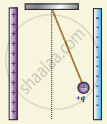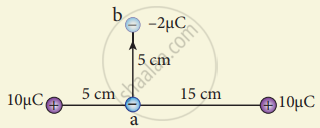Advertisements
Advertisements
Question
A spark plug in a bike or a car is used to ignite the air-fuel mixture in the engine. It consists of two electrodes separated by a gap of around 0.6 mm gap as shown in the figure.

To create the spark, an electric field of magnitude 3 x 106Vm-1 is required,
- What potential difference must be applied to produce the spark?
- If the gap is increased, does the potential difference increase, decrease or remains the same?
- Find the potential difference if the gap is 1 mm.
Solution
Separation gap between two electrodes, d = 0.6 mm
d = 0.6 × 10-3 m
Magnetude of electric field Electric field = E = 3 × 106 V m-1
Electric field E = `"V"/"d"`
(a) Applied potential difference, V = E . d
= 3 × 106 × 0.6 10-13 = 1.8 × 103
V = 1800 V
(b) From equation, V = E . d
If the gap (distance) between the electrodes increased, the potential difference also increases.
(c) Gap between the electrodes, d = 1mm = 1 x 10-3 m
Potential difference, V = E.d
= 3 × 106 × 1 × 10-3 = 3 × 103
V = 3000 V
APPEARS IN
RELATED QUESTIONS
Which charge configuration produces a uniform electric field?
A thin conducting spherical shell of radius R has a charge Q which is uniformly distributed on its surface. The correct plot for electrostatic potential due to this spherical shell is
Two points A and B are maintained at a potential of 7 V and -4 V respectively. The work done in moving 50 electrons from A to B is ______.
Define electrostatic potential.
What is an equipotential surface?
Give the relation between electric field and electric potential.
The total number of electrons in the human body is typically in the order of 1028. Suppose, due to some reason, you and your friend lost 1% of this number of electrons. Calculate the electrostatic force between you and your friend separated at a distance of lm. Compare this with your weight. Assume the mass of each person is 60kg and use point charge approximation.
Suppose a charge +q on Earth’s surface and another +q charge is placed on the surface of the Moon,
- Calculate the value of q required to balance the gravitational attraction between Earth and Moon
- Suppose the distance between the Moon and Earth is halved, would the charge q change?
(Take mE = 5.9 x 1024 kg, mM = 7.348 x 1022 kg)
Draw the free body diagram for the following charges as shown in the following figure.

A point charge of +10 µC is placed at a distance of 20 cm from another identical point charge of +10 µC. A point charge of -2 µC is moved from point a to b as shown in the figure. Calculate the change in potential energy of the system? Interpret your result.

